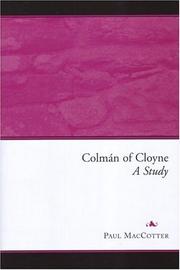| Listing 1 - 3 of 3 |
Sort by
|

ISBN: 9781851827930 1851827935 Year: 2004 Publisher: Dublin: Four Courts Press,
Abstract | Keywords | Export | Availability | Bookmark
 Loading...
Loading...Choose an application
- Reference Manager
- EndNote
- RefWorks (Direct export to RefWorks)
Colman mac Lénine --- Colman, - Saint, - d. 689? --- Cloyne, Co. Cork --- Ireland
Book
ISBN: 9781846822797 1846822793 Year: 2015 Publisher: Dublin Four Courts Press
Abstract | Keywords | Export | Availability | Bookmark
 Loading...
Loading...Choose an application
- Reference Manager
- EndNote
- RefWorks (Direct export to RefWorks)
This volume contains contributions from leading scholars working at the forefront of Irish medieval studies. It includes essays on archaeology, ecclesiology, hagiography, medieval history, genealogy, language, literature and toponymy. Subjects explored include : Latin and learning in early medieval Ireland; the historical context of early medieval literature; Viking armies and the importance of the Hiberno-Norse naval fleets; Ireland and its connections with the Scandinavian world; recent studies of wooden and Romanesque churches in pre-Norman Ireland; the coming of the Anglo-Normans; hitherto unpublished Anglo Norman charters ; the origin and function of medieval rural deaneries; secular and ecclesiastical histories of later medieval Kilkenny; and the ‘named son’ in 16th-century Ireland.
Archaeology, Medieval --- Middle Ages. --- Vikings --- Viking antiquities. --- Civilization, Viking --- Archéologie médiévale --- Moyen Age --- Antiquités vikings --- Civilisation viking --- Ó Corrãin, Donnchadh. --- Ireland --- Irlande --- History --- Civilization. --- Kings and rulers. --- Histoire --- Civilisation --- Rois et souverains --- Archéologie médiévale --- Antiquités vikings --- Ó Corráin, Donnchadh. --- Archaeology, Medieval - Ireland. --- Vikings - Ireland. --- Civilization, Viking - Ireland. --- Ó Corráin, Donnchadh --- Ireland - History - To 1603. --- Ireland - Civilization. --- Ireland - Kings and rulers.
Book
ISBN: 9781782054306 1782054308 Year: 2021 Publisher: Cork, Ireland Cork University Press
Abstract | Keywords | Export | Availability | Bookmark
 Loading...
Loading...Choose an application
- Reference Manager
- EndNote
- RefWorks (Direct export to RefWorks)
"Between the fifth century and the ninth, several thousand churches were founded in Ireland, a greater density than most other regions of Europe. This period saw fundamental changes in settlement patterns, agriculture, social organisation, rituals and beliefs, and churches are an important part of that story. The premise of this book is that landscape archaeology is one of the most fruitful ways to study them. By looking at where they were placed in relation to pagan ritual and royal sites, burial grounds, and settlements, and how they fared over the centuries, we can map the shifting strategies of kings, clerics and ordinary people. The result is a fascinating new perspective on this formative period, with wider implications for the study of social power and religious change elsewhere in Europe. The earliest churches, founded at a time of religious diversity (400-550), were often within royal landscapes, showing that some sections of the elite chose to make space for the new religion. These often lost out to new monasteries positioned at a remove from core royal land, making it possible to grant them the great estates on which their wealth was based (550-800). Now, however, founding churches was no longer a prerogative of kings for we see numerous lesser churches outside these estates. In this way middle-ranking people helped transform the landscape and shape religious cultures in which rituals and beliefs of local origin co-existed alongside Christianity. Finally, in the Viking Age (800-1100), some lesser churches were abandoned while community churches began to exert more of a gravitational pull, foreshadowing the later medieval parish system."--Back cover.
Church buildings --- Landscape archaeology --- History --- Ireland --- Ireland --- History --- Church history
| Listing 1 - 3 of 3 |
Sort by
|

 Search
Search Feedback
Feedback About
About Help
Help News
News